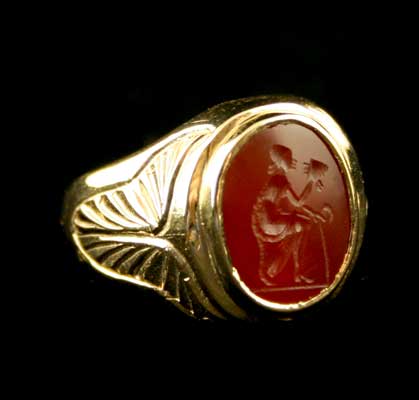Gold Ring Featuring a Classical Revival Carnelian Intaglio of Penelope, 18th Century CE - 19th Century CE
Carnelian and Gold
FJ.6799
This Gorgeous Intaglio Has Been Mounted in a Modern 18 Karat Gold Rin The art of glyptics, or carving on colored precious stones, is probably one of the oldest known...
This Gorgeous Intaglio Has Been Mounted in a Modern 18 Karat Gold Rin
The art of glyptics, or carving on colored precious stones, is probably one of the oldest known to humanity. Intaglios, gems with an incised design, were made as early as the fourth and third millennia B.C. in Mesopotamia and the Aegean Islands. They exhibit a virtuosity of execution that suggests an old and stable tradition rooted in the earliest centuries. The tools required for carving gems were simple: a wheel with a belt-drive and a set of drills. A special difficulty of engraving intaglios, aside from their miniature size, was that the master had to work with a mirror-image in mind.
When Odysseus failed to return home from the Trojan War (he was delayed for ten years), his wife Penelope was beset by suitors. In order to delay their request for marriage, she insisted that she could not remarry until she had finished weaving a shroud for Odysseus' father, Laertes. She worked each day at her loom, and then unraveled the cloth each night. After three years of successful delay, one of her servants revealed her deception, and the impatient suitors angrily demanded that she choose one of them for her husband immediately. Penelope said that she would marry the man who could string Odysseus' bow and shoot an arrow through twelve axes. By this time, Odysseus himself had secretly returned, disguised as a beggar; he passed the test of the bow, and revealed himself to his wife. Here, Penelope is revealed seated at a loom holding a weaving comb.
The Classical Revival was a phenomenon that swept through Europe in the 18th and 19th Centuries. A new appreciation for antiquity and ancient art forms was fostered by discoveries in the nascent scientific field of archaeology. Perhaps the Classical Revival also reveals a latent longing towards the Arcadian lifestyles of yesterday abandoned as Europe became rapidly industrialized and increasingly urbanized. This ring is a memorial to the glories of Classical antiquity seen anew through eyes of 18th century Europe.
The art of glyptics, or carving on colored precious stones, is probably one of the oldest known to humanity. Intaglios, gems with an incised design, were made as early as the fourth and third millennia B.C. in Mesopotamia and the Aegean Islands. They exhibit a virtuosity of execution that suggests an old and stable tradition rooted in the earliest centuries. The tools required for carving gems were simple: a wheel with a belt-drive and a set of drills. A special difficulty of engraving intaglios, aside from their miniature size, was that the master had to work with a mirror-image in mind.
When Odysseus failed to return home from the Trojan War (he was delayed for ten years), his wife Penelope was beset by suitors. In order to delay their request for marriage, she insisted that she could not remarry until she had finished weaving a shroud for Odysseus' father, Laertes. She worked each day at her loom, and then unraveled the cloth each night. After three years of successful delay, one of her servants revealed her deception, and the impatient suitors angrily demanded that she choose one of them for her husband immediately. Penelope said that she would marry the man who could string Odysseus' bow and shoot an arrow through twelve axes. By this time, Odysseus himself had secretly returned, disguised as a beggar; he passed the test of the bow, and revealed himself to his wife. Here, Penelope is revealed seated at a loom holding a weaving comb.
The Classical Revival was a phenomenon that swept through Europe in the 18th and 19th Centuries. A new appreciation for antiquity and ancient art forms was fostered by discoveries in the nascent scientific field of archaeology. Perhaps the Classical Revival also reveals a latent longing towards the Arcadian lifestyles of yesterday abandoned as Europe became rapidly industrialized and increasingly urbanized. This ring is a memorial to the glories of Classical antiquity seen anew through eyes of 18th century Europe.



